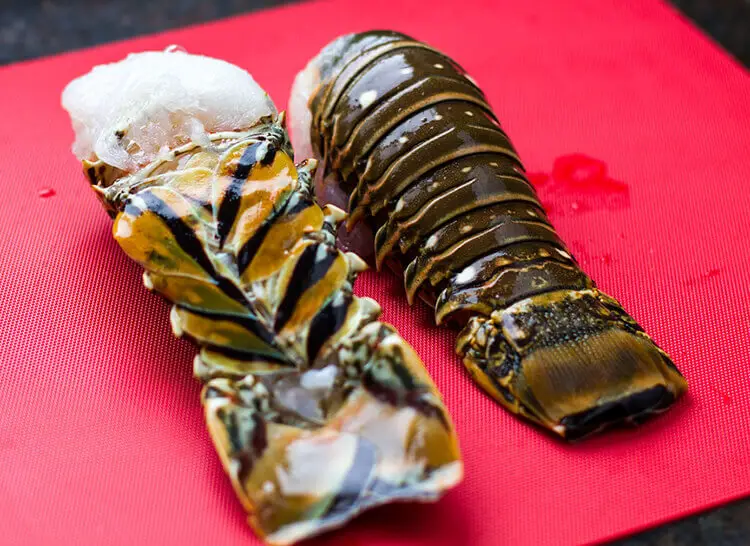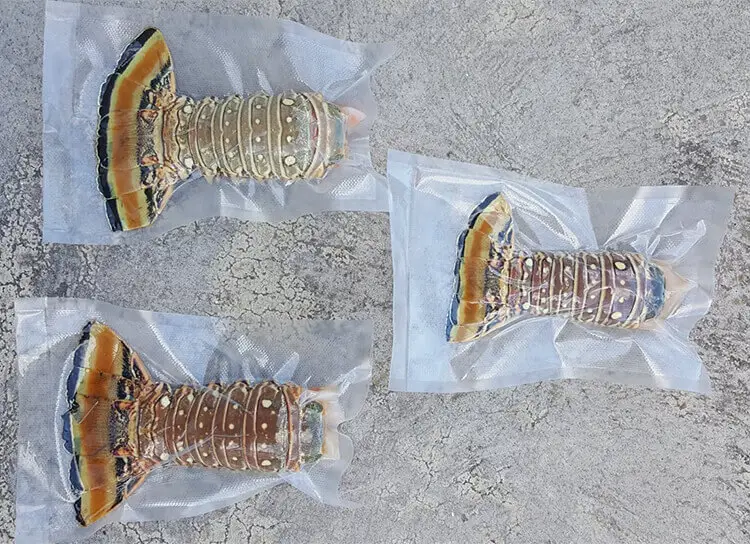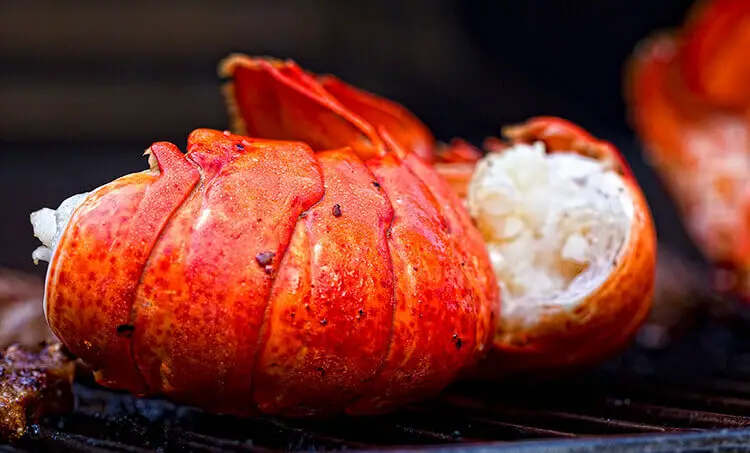Lobster tails taste best when fresh. But if you can’t finish them all at once, consider storing the leftovers in the fridge.
How long can lobster tails stay in the fridge? This article will give you a complete guide to this question. Also, do not miss the signs of spoiled food to protect yourself from food poisoning. Let’s jump into the details!
How Long Can Lobster Tails Stay in the Fridge?
If you store cooked lobster tails in the fridge, they can last about three days there. Raw tails will last longer, up to five days.
The problem with cooked food is that you have added various ingredients and seasonings to them. Hence, when storing such food, we advise consuming them as soon as possible.
Raw Lobster Tails
Raw lobster tails can remain good in your refrigerator for up to five days if treated properly. If you’re unsure about how long they can last, consider the following advice as a guide:
- Set your fridge’s temperature at 40°F. The meat of your lobsters will rot more quickly if the temperature increases.
- When storing your tails in the refrigerator, ensure to submerge all of their parts thoroughly in ice or water.


Cooked Lobster Tails
If you have any leftovers, you may keep them for about three days in your refrigerator. But there are several safety measures to follow.
To maintain their taste and safety, you should refrigerate cooked lobster tails right when you finish cooking.
Besides, drain off all the water and meat juices of the lobster tails before cooking them in your fridge.
Another piece of advice is to use airtight containers to store your cooked lobster tails. In this manner, moisture can’t find its way to penetrate your food and form condensation there.
How to Store Lobster Tails in the Fridge
The lobster tails are quite fragile. They soon spoil if you don’t prepare them straight away. But if you know the way, you can keep your food in the refrigerator for a few more days.
It’s ideal for storing lobster tails in their supermarket packaging, as with any other meat product. Then, put the packs in the coldest area of the refrigerator, away from temperature changes and the door.
If your lobster tails don’t come in sealed packaging, put them in airtight containers to decrease airflow and minimize the chance of cross-contamination.
To prevent them from drying out while you’re ready to use them, you can also store lobster tails in your refrigerator with an ice pack or cover them in a moist cloth.
Another method is to submerge the meat in melted butter or water in the fridge. However, the taste and texture of your food will change over time.


Read more: A step-by-step guide to preserving lobster shells
How to Tell If Lobster Tails Are Bad
Before taking your lobster tails from the fridge, you should check for signs of spoilage first. Here are five things to examine about your food to avoid food poisoning.
Appearance
The lobster meat beneath the patterned blue-green shell of the raw lobster tail should have a transparent white hue. Any changes from this suggest that your food is no longer safe to cook and eat.
If you store cooked lobster tails, either store-bought or homemade, the shell should be orange-red, and the flesh should be white with some red splashes. If the flesh turns green or lime-white, it isn’t edible.
Smell
Raw lobster tails have a seaside aroma that makes you want to head for the beach. But if they turn fishy, you’d better throw them away.
You can sniff the tails carefully to check their smell. If it’s revolting and pungent, your food may have gone spoiled.
Perform the same test on cooked lobster tails. The rule doesn’t change in this case: The meat is unsafe to eat if it has a fishy smell.
Texture
The texture of raw lobster tails should be firm and slightly dry because it has been out of the water. Meanwhile, the shells have smooth patches and a rougher overall texture.
The lobster tail has gone rotten if the shell looks slimy or if the meaty flesh turns mushy and gooey like cream cheese.
On the other hand, the cooked lobster tail meat should also be dry, firm, and maintain its shape. Slimy, soft, or squishy meat is a sign of spoilage.
Taste
Of course, you can’t eat raw lobster tails even when they haven’t gone bad. So you will only check for the taste of cooked meat.
You will realize the sour taste if you accidentally eat spoiled lobster tails. You may also feel the mustiness that is unpalatable.
Mold
Mold doesn’t often grow on raw lobster tails. If you see any growths, your food must have decayed, and the only thing you can do is throw it away. The same stays true for cooked lobster tails.


Can You Keep Lobster in the Freezer?
If you don’t plan to use your lobster tails soon, putting them in the freezer will be the best storage method. They can last for months in such freezing temperatures.
When frozen correctly, lobster tails may even remain good for one year. Then, your food only deteriorates in texture.
To freeze lobster tails, wrap them carefully in a sealed container and place it in the freezer immediately. This method will prevent bacteria from growing and spreading within your food.
To thaw frozen lobster, put it in the fridge overnight. The best temperature to defrost is below 40 degrees Fahrenheit.
Thawed lobster tails can last up to two days in the refrigerator if stored properly. It’s important to keep lobster tails in an airtight container or wrap them tightly with cling film to prevent them from drying out or absorbing other flavors in the refrigerator.
If you do not plan to use lobster tails after this time, it is best to refreeze them to maintain their quality and freshness.
This video will show you more tips on how to freeze and preserve lobster tails:
Conclusion
Lobster tails can last about 3 days in your fridge when cooked and five days if still raw. However, you should learn how to refrigerate them correctly to lengthen their lifespan.
Besides, do not forget to check for signs of spoilage when taking lobster meat from the fridge. If you live in warmer regions, we highly recommend freezing them.
Hopefully, storing lobster tails won’t bother you anymore. If you need extra tips for this task, don’t be shy to contact us. We welcome all the questions.
Thank you for stopping by!
















Greetings! Very helpful advice within this
post! It’s the little changes that produce the greatest changes.
Thanks for sharing!
Thank you for your kind comment! We’re happy to hear that you found our post helpful, and we will keep providing valuable seafood information. Have a wonderful day!
I am sure this paragraph has touched all the internet people, its
really really fastidious article on building up new weblog.
Thank you so much! We’re glad you enjoyed the article. Your positive feedback encourages us to keep delivering valuable content. Have a nice weekend!
Wow, this piece of writing is pleasant, my sister is analyzing these kinds of things,
so I am going to let know her.
Thank you for your comments! We’re glad you found the content useful. We have many research articles about lobster that you might like; please try them out. Sincerely, thank you. Have a good day.
I read this article completely about the resemblance of hottest and earlier technologies, it’s remarkable article.
Thank you for reading the article! Your positive feedback is the most wonderful thing for us. We’re here to provide more valuable content, always.
I’ve read several good stuff here. Definitely worth bookmarking for revisiting. I surprise how much effort you put to create such a great informative site.
Hi there friends, good post and good urging commented
at this place, I am really enjoying by these.
I really like your writing style, fantastic info, thanks for posting :D. “God save me from my friends. I can protect myself from my enemies.” by Claude Louis Hector de Villars.
I see something really special in this internet site.
Its like you read my mind! You appear to know so much about this, like you wrote the book in it or something. I think that you can do with a few pics to drive the message home a bit, but instead of that, this is magnificent blog. A great read. I will certainly be back.
Oh my goodness! Awesome article dude! Thank you, However I am experiencing difficulties with your RSS. I don’t know why I am unable to subscribe to it. Is there anyone else having the same RSS problems? Anyone that knows the answer will you kindly respond? Thanks!!
Hey, thanks for the kind words! I’m sorry to hear you’re having trouble with the RSS. I’ll look into it, and in the meantime, appreciate your patience. Thanks for bringing it to my attention!
Good post. I learn something new and challenging on websites I stumbleupon everyday.
It’s always helpful to read content from other authors and use something from their
sites.
This is a topic which is near to my heart… Best wishes! Exactly where are your contact details though?
As soon as I found this internet site I went on reddit to share some of the love with them.
Limit your stake amount The most vital issue is that the bookmaker knows
which events make a sure bet.
Gems form the internet very few websites that happen to be detailed below, from our point of view are undoubtedly well worth checking out…
Link exchange is nothing else except it is just placing the
other person’s website link on your page at proper place and other
person will also do same in support of you.
Whats Going down i am new to this, I stumbled upon this I have discovered It positively useful and it has aided me out loads. I’m hoping to give a contribution & assist other users like its aided me. Good job.
Normally I do not learn post on blogs, but I wish to say that this write-up very
forced me to take a look at and do so! Your writing taste has been amazed me.
Thanks, quite nice article.
I loved as much as you’ll receive carried out right here.
The sketch is tasteful, your authored material stylish.
nonetheless, you command get got an nervousness over that you wish
be delivering the following. unwell unquestionably come further formerly again as exactly the
same nearly very often inside case you shield this increase.
I was looking through some of your posts on this internet site and I think this website is rattling informative! Continue posting.
Hi there to every body, it’s my first pay a quick visit of this webpage; this website contains remarkable and
really fine data for readers.
Inspiring quest there. What occurred after? Good luck!
Sweet blog! I found it while searching on Yahoo News.
Do you have any suggestions on how to get listed in Yahoo News?I’ve been trying for a while but I never seem to get there!
Many thanks
I do accept as true with all the concepts you have offered in your post.
They are really convincing and can definitely
work. Still, the posts are very quick for starters. Could you please extend them a little from next time?
Thank you for the post.
If you want to get a great deal from this paragraph then you have to apply these methods to your won blog.
I don’t even understand how I ended up right here,
however I thought this post used to be good. I do not realize who you are but certainly you’re going to a famous blogger for those
who are not already. Cheers!
Hey I know this is off topic but I was wondering if
you knew of any widgets I could add to my blog that automatically tweet my newest twitter updates.
I’ve been looking for a plug-in like this for quite some time and
was hoping maybe you would have some experience with something like this.
Please let me know if you run into anything. I truly enjoy reading your blog and I
look forward to your new updates.ラブドール
Wonderful blog! I found it while browsing on Yahoo News.
Do you have any tips on how to get listed in Yahoo News?
I’ve been trying for a while but I never seem to get there!
Appreciate it
Everyone loves it when individuals come together and share
opinions. Great blog, keep it up!
I need to to thank you for this excellent read!!
I certainly loved every bit of it. I have got you saved as a favorite to check out new things you post…
Wow! This blog looks just like my old one! It’s on a entirely different subject but it has
pretty much the same layout and design. Great choice of colors!
Excellent way of telling, and pleasant article to get information on the topic of my presentation subject matter, which i am going to convey in university.
Be sure to locate a place that offerエロ 人形 ample support for her system when standing. We really propose the following 6 spectacular sexual intercourse positions that you should check out with your real love doll:
Hello! Thank you for bringing this to our attention. We apologize for any inconvenience you’ve experienced. We’ll look into resolving the overlapping problem on Internet Explorer to ensure a seamless experience for all our visitors. Please feel free to reach out if you encounter any further issues. Thank you for your support!
It’s impressive that you arre getting ideas from
this post as well as from oour dialogue made here.
I like the valuable info you provide in your articles.
I’ll bookmark your weblog and check again here frequently.
I am quite certain I’ll learn lots of new stuff right here!
Good luck for the next!
Your style is very unique compared to other folks I’ve read stuff from.
Thanks for posting when you have the opportunity, Guess I’ll just bookmark this blog.
I love your blog.. very nice colors & theme.
Did you design this website yourself or did you hire someone to do it
for you? Plz respond as I’m looking to construct
my own blog and would like to know where u got this from. appreciate itエロ 下着
situs slot situs slot situs slot situs slot
Highly descriptive post, I loved that a lot. Will there be a part
2?
pttogel pttogel pttogel pttogel
Awesome article.
x people are watching this item,” unnecessary countdown timers, etc. Those are fake, deceptive, and unprofessional.
hondatoto hondatoto hondatoto hondatoto hondatoto
A person necessarily assist to make severely articles I’d state.
This is the first time I frequented your website page and
so far? I amazed with the analysis you made
to make this particular put up incredible. Fantastic task!
nanastoto nanastoto nanastoto nanastoto nanastoto
Its like you read my mind! You seem to know so much
about this, like you wrote the book in it or something.
I think that you could do with some pics to drive the message home a bit,
but instead of that, this is magnificent blog. A fantastic read.
I’ll definitely be back.
ligaciputra ligaciputra ligaciputra ligaciputra ligaciputra
I absolutely love your site.. Pleasant colors & theme.
Did you develop this amazing site yourself? Please reply back as
I’m planning to create my own personal blog and want
to find out where you got this from or just what the
theme is named. Thanks!
tokekwin tokekwin tokekwin tokekwin tokekwin
Hey there! This is kind of off topic but I need some guidance from an established blog.
Is it tough to set up your own blog? I’m not very techincal but I can figure things out
pretty fast. I’m thinking about setting up my own but I’m not sure
where to begin. Do you have any ideas or suggestions? With thanks
Your point of view caught my eye and was very interesting. Thanks. I have a question for you.
Ganhe no Cassino Online curso beta com Jogos Simples e Populares!
jogos win: Jogue e Ganhe Agora com Facilidade!
Como Realizar Saques na bolsa de aposta Sem Enfrentar Problemas
Tudo Sobre Saque na futmax futebol ao vivo: Como Retirar Seus Ganhos de Forma Rápida e Segura
A jogos ao vivo futebol tem um sistema eficiente para garantir que seu saque seja
processado de maneira ágil e segura.
A Importância da Verificação de Documentos no Saque da tv brasil futebol ao vivo
Your enticle helped me a lot, is there any more related content? Thanks!